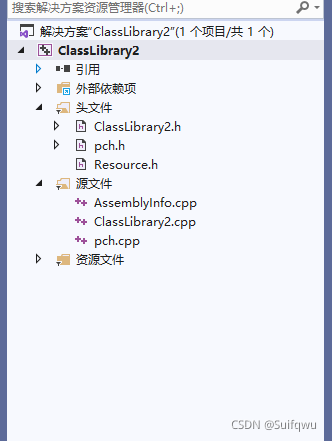Qt之调用C#的动态库的解决方法
环境:VS2019+Qt5.12
1. CLR库安装首先,如果你VS2019没有安装CLR库,那么操作步骤为:
打开 Visual Studio Installer
在已安装中点击修改
将使用C++的桌面开发的对V142(14.25)生成工具的C++/CLI支持
点击右下角的修改,安装完成后重启软件即可
2. 新建类库(.NET Framework)注意:此处请确认选择用于创建C#类库(.dll)的项目
此时解决方案的视图为:

一个简单的测试直接在Class1.cs文件添加内容即可,此测试中只修改此文件内容
using System;
using System.Collections.Generic;
using System.Linq;
using System.Text;
using System.Threading.Tasks;
namespace ClassLibrary1
{
public class Class1
{
public Class1() { }
public int myAdd(int a, int b)
{
int c = a + b + 5;
return c;
}
public void mySub(int a, int b, ref int c)
{
c = a - b - 5;
}
public void mySetText(string text)
{
Console.WriteLine("ClassLibrary1的类名Class1下的mySetText: {0}", text);
}
public void myGetText(ref string text)
{
text = "ClassLibrary1的类名Class1下的myGetText";
}
}
}
编写好了之后生成dll,将生成的dll复制到CLR的文件路径下
3. 新建CLR类库(.NET Framework)此时解决方案的视图为:

一个简单的测试对应的头文件ClassLibrary2.h修改即可,此测试中只修改此文件内容
#pragma once
using namespace System;
using namespace System::Reflection;
using namespace System::Runtime::InteropServices;
#using "./ClassLibrary1.dll"
using namespace ClassLibrary1;
extern "C" __declspec(dllexport) int MyAdd(int a, int b)
{
ClassLibrary1::Class1 obj;
return obj.myAdd(a, b);
}
extern "C" __declspec(dllexport) void MySub(int a, int b,int *c)
{
ClassLibrary1::Class1 obj;
return obj.mySub(a, b, *c);
}
extern "C" __declspec(dllexport) void MySetText(char* text)
{
ClassLibrary1::Class1 obj;
String^ str = gcnew String(text);
obj.mySetText(str);
}
extern "C" __declspec(dllexport) void MyGetText(char** text)
{
ClassLibrary1::Class1 obj;
String^ str = gcnew String("");
obj.myGetText(str);
*text = (char*)(void*)Marshal::StringToHGlobalAnsi(str);
}
这里编写完成后生成dll,然后非常重要的一步来了,将ClassLibrary1.dll、ClassLibrary2.dll、ClassLibrary2.lib准备复制到运行的Qt执行目录下,如果没有在同一个目录下,在ClassLibrary2调用ClassLibrary1时会找不到ClassLibrary1.dll文件而报错
4. Qt调用 4.1. 调用方法1
#include <QCoreApplication>
#include <windows.h>
#include <QDebug>
#include <QLibrary>
#include <QFile>
typedef int (*ADD)(int,int);
typedef void (*SUB)(int,int,int *);
typedef void (*SHOW)(QString);
int main(int argc, char *argv[])
{
QLibrary mylib("ClassLibrary2.dll"); //声明dll文件
if (mylib.load()) //判断加载是否成功
{
qDebug() << "DLL loaded!";
ADD add = (ADD)mylib.resolve("MyAdd"); //链接到add函数
qDebug() << "add status: " << add;
if (add){
qDebug()<< "Link to add Function is OK!" << add(3,2) ;
}
SUB sub = (SUB)mylib.resolve("MySub");
qDebug() << "sub status: " << sub;
if (sub){
int c = 10;
sub(3,2,&c);
qDebug()<< "Link to sub Function is OK!" << c;
}
SHOW show = (SHOW)mylib.resolve("MySetText");
qDebug() << "show status: " << show;
if (show){
qDebug()<< "Link to show Function is OK!" ;
const char *buf = "helloworld";
show(buf);
}
qDebug()<< "DLL unload " << mylib.unload ();
}
else
{
qDebug()<< "DLL is not loaded!" ;
}
return 0;
}
4.2. 调用方法2
右键项目->选择添加库->选择外部库
在库文件中找到刚才生成的ClassLibrary2.lib
将平台下的linux、Mac取消勾选
将Windows下的所有都取消勾选
此时界面如下

extern "C" __declspec(dllexport) void MyGetText(char **p);
extern "C" __declspec(dllexport) void MySetText(char *p);
int main(int argc, char *argv[])
{
MySetText(QString("helloworld").toUtf8().data());
char* change_t=nullptr;
MyGetText(&change_t);
qDebug() << QString(change_t);
}
到此这篇关于Qt之调用C#的动态库的文章就介绍到这了,更多相关Qt调用C#动态库内容请搜索软件开发网以前的文章或继续浏览下面的相关文章希望大家以后多多支持软件开发网!
相关文章
Jenna
2020-10-09
Haile
2020-12-09
Serwa
2020-03-20
Isadora
2020-08-10
Rae
2023-07-22
Rhoda
2023-07-22
Hester
2023-07-22
Grace
2023-07-22
Vanna
2023-07-22
Peony
2023-07-22
Dorothy
2023-07-22
Dulcea
2023-07-22
Zandra
2023-07-22
Serafina
2023-07-24
Kathy
2023-08-08
Olivia
2023-08-08
Elina
2023-08-08
Jacinthe
2023-08-08
Viridis
2023-08-08
Hana
2023-08-08